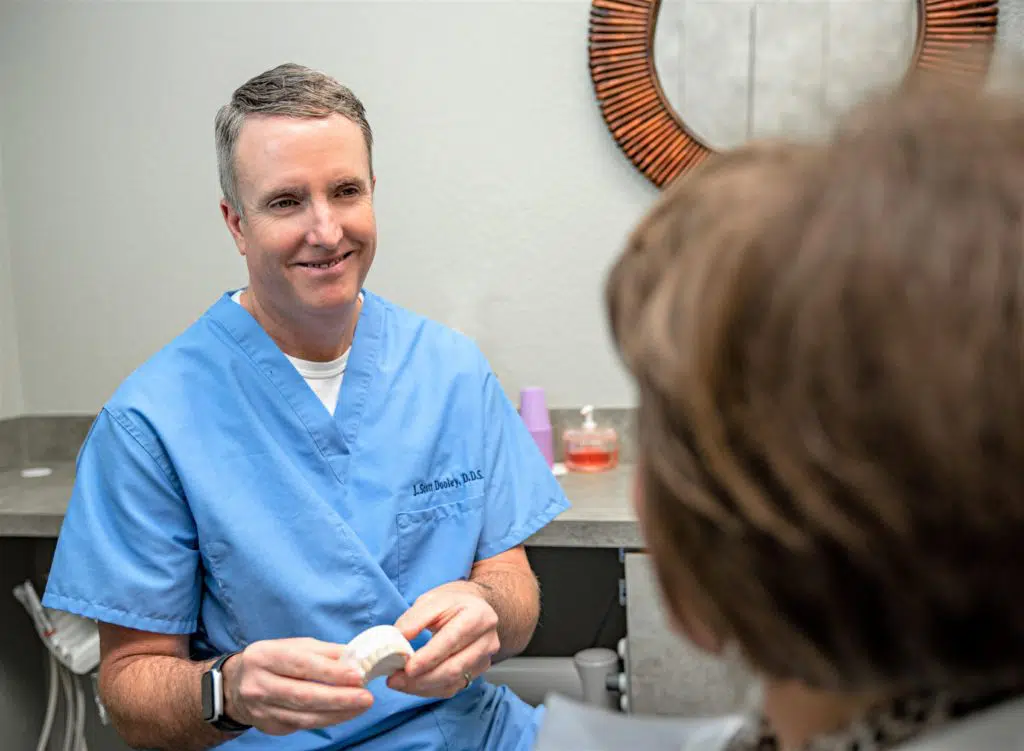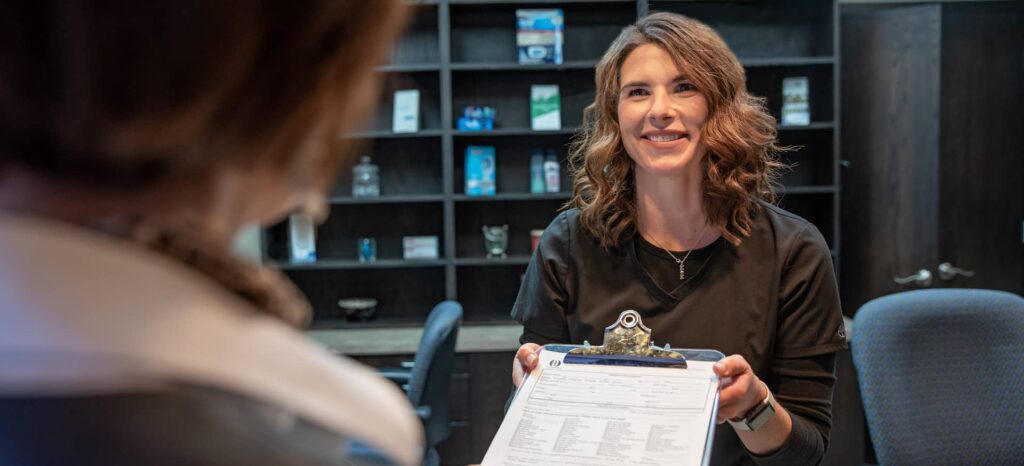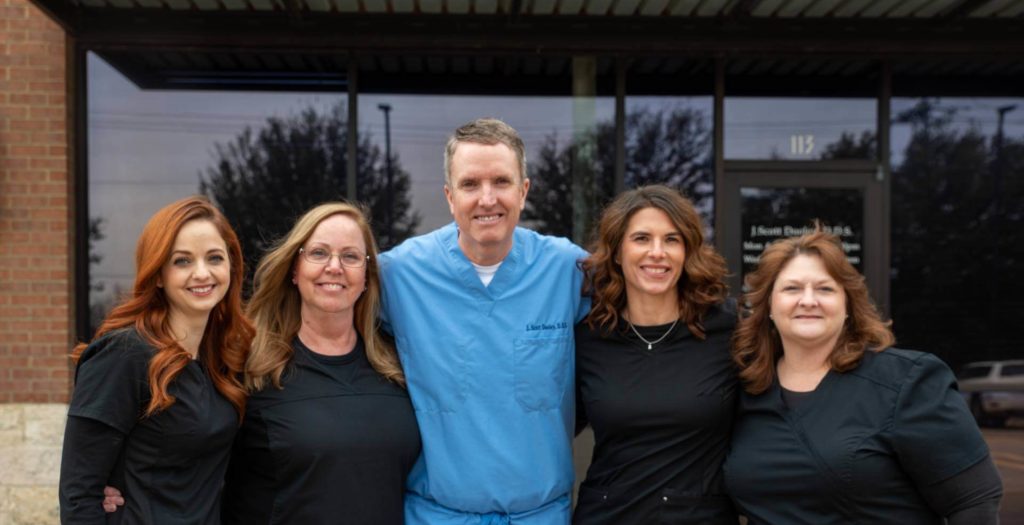Dental damage can affect your health and quality of life. You may experience a toothache or impaired dental function, or you may simply feel embarrassed about the look of your smile. Fortunately, Dr. Dooley and his team offer a full range of restorative treatments that can improve your oral function and help you feel great about your smile.
What Is Restorative Dentistry?
Restorative dentistry is the unsung hero in the world of dental health, providing the solutions we need when our teeth face challenges. Life can be tough on our teeth; from enjoying our favorite foods to unexpected accidents, our teeth can sometimes take a hit. This is where restorative dentistry steps in. It’s the field that’s all about getting your smile back to its best – strong, functional, and beautiful.
It’s about more than just aesthetics, too. Our teeth play a vital role in our overall health, from allowing us to eat a range of foods to form the structure of our faces. When they’re not at their best, it can affect everything from our nutrition to our self-confidence. So why might you need restorative dentistry? Perhaps you’ve noticed changes in your bite, discomfort when eating or drinking, or maybe your smile just isn’t as radiant as it once was. These are all signs that restorative dentistry could help.
At the end of the day, restorative dentistry is all about empowering you to live your life to the fullest without having to worry about your teeth. It’s about restoring not just your smile but your confidence and enjoyment in life. So why wait? Start your journey to a healthier, happier smile today!
Our restorative treatments include the following:
Dental fillings
Dental fillings are a common restorative treatment used to repair teeth that have been damaged by decay or cavities. The process involves removing the decayed portion of the tooth and “filling” the area with a replacement material. This material can be made from various substances, including composite resin (which matches the color of your natural teeth), silver amalgam, gold, or porcelain.
The purpose of a dental filling is two-fold: first, it prevents further decay by sealing off any cracks or crevices where bacteria can enter. Second, it restores the tooth’s shape and function, enabling you to chew, bite, and speak normally.
The treatment is straightforward and usually carried out under local anesthesia, so it’s painless. Afterward, the filled tooth can last many years with proper care, including regular brushing, flossing, and dental check-ups. Dental fillings are a simple, effective way to keep your smile healthy and prevent small dental issues from becoming bigger problems. Learn more about dental fillings here!
Dental Crowns
Dental crowns, often referred to as “caps,” are fixed prosthetic devices used in restorative dentistry. They are designed to cover or “cap” a damaged tooth, enhancing its shape, size, strength, and appearance. Crowns are used for a variety of reasons: to protect a weak tooth from breaking, to restore an already broken tooth, to cover and support a tooth with a large filling when there isn’t much of the tooth left, or to hold a dental bridge in place.
A crown is also often used to cover a discolored or poorly shaped tooth or to cover a dental implant. They are custom-made to fit over your entire tooth from the gum lineup and can be made from a variety of materials, such as porcelain, ceramic, resin, or metal.
The process of getting a crown usually involves a few steps and several visits to the dentist. But once in place, a crown functions just like a natural tooth. You can bite, chew, and smile with confidence, knowing your dental crown has restored not only the function of your tooth but its appearance as well. It’s like giving your tooth a second chance. Learn more about dental crowns here!
Inlays and Onlays
Inlays and onlays are types of dental restorations that offer a middle ground between fillings and full crowns. They are used when the tooth damage is too extensive for a filling but not severe enough to require a crown.
An inlay is used when the damage is within the cusp tips of a tooth, meaning it fits inside the top edges of the tooth. An onlay, on the other hand, is used when the damage extends beyond one or more of the cusps of the tooth. It covers a larger area and is sometimes referred to as a “partial crown.”
Inlays and onlays are typically made from durable materials like porcelain or composite resin, which can be matched to the natural color of your teeth. One of the main benefits of inlays and onlays is that they allow for the preservation of a more natural tooth structure, which can be beneficial for the long-term health of the tooth.
The process of getting inlays or onlays usually involves two appointments: one to prepare the tooth and take an impression and a second to fit the inlay or onlay onto the tooth. With good oral hygiene, inlays and onlays can last a long time, helping to keep your smile strong and healthy. They are an excellent solution when you need more than a filling but less than a full crown. Learn more about Inlays and Onlays here!
Dental Bridges
Dental bridges are a type of restorative dental treatment used to replace one or more missing teeth. As the name suggests, a dental bridge “bridges” the gap left by missing teeth, helping to restore both the function and aesthetics of your smile. A traditional dental bridge consists of two or more crowns (called abutment teeth) and a false tooth/teeth (called pontics) in between. The crowns are placed on the teeth adjacent to the gap, serving as strong anchors, while the pontics fill in where the teeth are missing.
Bridges can be made from a variety of materials, including porcelain, ceramics, or metal, often chosen to match the color of your natural teeth. Once in place, a dental bridge can help improve your ability to chew and speak properly, maintain the shape of your face, and prevent your remaining teeth from shifting out of position.
The process of getting a dental bridge usually involves multiple visits to our dentist in Garland, but the final result is a stable, long-lasting restoration that blends in seamlessly with your natural teeth. By restoring your missing teeth, dental bridges can help you regain your smile and your confidence. Learn more about dental bridges here!
Dental Implants
Dental implants are a popular and effective long-term solution for replacing missing teeth. Unlike dentures or bridges, which sit on top of the gums, an implant is surgically placed into the jawbone, providing a sturdy base for an artificial tooth or crown.
A dental implant is essentially a small titanium post that serves as a substitute for the root portion of the missing tooth. Over time, the implant fuses with the bone in a process called osseointegration, providing strong support just like a natural tooth root. An abutment, or connector, is then placed on top of the implant to hold the replacement tooth.
One of the key advantages of dental implants is that they help preserve jawbone, preventing bone loss that often occurs under missing teeth. They also provide stability and comfort, eliminating some of the key problems of dentures, including poor fit, gum irritation, and the need for adhesives.
Dental implants can replace a single tooth, several teeth, or all teeth. The process of getting implants requires a number of visits over several months, but the result is a sturdy, natural-looking tooth that functions just like your own. Whether you’re missing one tooth or several, dental implants could be an excellent investment in your oral health, your comfort, and your appearance. Learn more about dental implants here!
Dentures
Dentures are removable appliances that can replace missing teeth and help restore your smile if you’ve lost all or some of your natural teeth, whether from gum disease, tooth decay, or injury, dentures can replace your missing teeth and your smile.
There are two main types of dentures: full and partial. Full or complete dentures are used when all the teeth are missing, while partial dentures are used when some natural teeth remain and fill in the spaces created by missing teeth. Dentures not only improve the appearance of your smile by filling in the gaps left by missing teeth, but they also help support facial structure and improve speech and eating functions.
Getting used to dentures can take a bit of time, and they will never feel exactly the same as one’s natural teeth, but today’s dentures are natural looking and more comfortable than ever. Whether you need full or partial dentures, they’re a great solution to replace missing teeth and regain a confident smile. Learn more about dentures here!
Root Canals
A root canal is a dental procedure designed to save a tooth that’s badly decayed or infected. Inside each tooth, beneath the white enamel and hard layer called dentin, is a soft tissue called pulp. This tissue contains blood vessels, nerves, and connective tissue, which help grow the root of your tooth during development. But when the pulp becomes inflamed or infected due to deep decay, repeated dental procedures, faulty crowns, or a crack or chip in the tooth, it can cause pain and, if left untreated, lead to an abscess or even tooth loss.
During a root canal procedure, Dr. Dooley removes the inflamed or infected pulp, carefully cleans and shapes the inside of the root canal, then fills and seals the space. Afterward, the tooth is restored with a crown or filling for protection and will continue to function like any other tooth. Root canal therapy often has a reputation for being painful, but in reality, the procedure itself is no more uncomfortable than getting a filling. In fact, it’s a highly effective way to alleviate tooth pain and save your natural tooth – so you can keep your smile complete and functional. Learn more about root canals here!
Tooth Extractions
Tooth extractions are dental procedures where a tooth is completely removed from its socket in the bone. In most cases our dentist will try to save a tooth whenever possible, but there are situations where extraction is the best or only solution. These can include severe tooth decay, advanced gum disease, infection, crowding, or impacted teeth (like wisdom teeth that don’t have enough space to grow properly).
There are two types of extractions: a simple extraction, where the dentist loosens the tooth with an instrument called an elevator and then removes it with dental forceps, and a surgical extraction, which is a more complex procedure used if a tooth may have broken off at the gum line or has not come into the mouth yet.
Tooth extractions are performed under local anesthesia, so you shouldn’t feel any pain during the procedure, just pressure. Post-procedure discomfort can usually be managed with over-the-counter painkillers and by following our dentist’s aftercare instructions, like using ice packs to reduce swelling and eating soft foods.
While the idea of having a tooth removed can be daunting, remember that tooth extractions are common procedures, and Dr. Dooley is skilled at ensuring your maximum comfort. Plus, there are many effective options for replacing an extracted tooth and restoring your smile, like bridges, implants, or dentures. Learn more about tooth extractions here!
The Importance of Restorative Treatment
Our various restorative dental treatments can ease your discomfort and prevent further tooth damage. In addition, dental restorations will help you to eat and speak normally. Finally, if dental damage has impacted your self-esteem, our restorative treatments will help you to smile with confidence.
We offer high-quality restorations made from advanced dental materials. Our porcelain and zirconia come in a range of shades, and they provide a lifelike sparkle that is virtually identical to dental enamel. Plus, whether you choose one of these materials or you select a metal restoration, our lab will make sure that your prosthetic fits comfortably and maintains your healthy dental alignment.
Why You Should Replace Missing Teeth
Replacing missing teeth is crucial, not just for the sake of your appearance but for your overall oral health and well-being. When you lose a tooth, it can lead to a cascade of problems that go beyond a simple gap in your smile.
Firstly, missing teeth can impact your ability to chew and speak properly. This can affect your diet and nutrition, potentially leading to health problems down the line. It can also affect your speech, making it harder to pronounce certain words and potentially impacting your confidence when talking to others.
Secondly, teeth play a crucial role in supporting the structures of the mouth. When a tooth is missing, the surrounding teeth can shift into the empty space, leading to a change in your bite that can make chewing difficult and may require orthodontic treatment to correct.
Moreover, missing teeth can lead to bone loss in your jaw. The roots of our teeth stimulate the jawbone, helping to keep it strong. When a tooth is missing, the lack of stimulation can cause the jawbone to deteriorate, potentially leading to changes in your facial structure and premature aging.
Finally, missing teeth can affect your self-esteem and quality of life. A complete, healthy smile is often seen as a sign of health and attractiveness, and gaps from missing teeth can make people feel self-conscious about their appearance.
In conclusion, replacing missing teeth is essential to maintain your oral health, functionality, facial aesthetics, and self-confidence. With modern dental advancements, there are several effective options for tooth replacement, including dental implants, bridges, and dentures. It’s never too late to restore your smile and improve your dental health. Learn more about the importance of replacing missing teeth here!
Do You Need Restorative Care?
If you are suffering from any of the following types of dental damage, you are likely a good candidate for restorative care:
- Cavities
- Cracked or weakened teeth
- A dental infection
- Missing teeth
- Loose teeth
Schedule a Restorative Dentistry Consultation!
At Scott Dooley Dentistry in Garland, TX, we understand the profound impact that a healthy, complete smile can have on your life. It’s not just about looking great – it’s about feeling confident, enjoying your favorite foods, speaking clearly, and maintaining your overall oral health. Whether you’re dealing with missing teeth or need restoration work, we’re here to help. Our experienced team offers a range of treatments, from dental implants and bridges to dentures and crowns, designed to restore your smile and your confidence. Don’t let missing teeth or oral discomfort hold you back any longer. Contact our dentist in Garland today to schedule a consultation, and let us help you start your journey toward a healthier, happier smile. You deserve the best, and we’re committed to providing just that!





